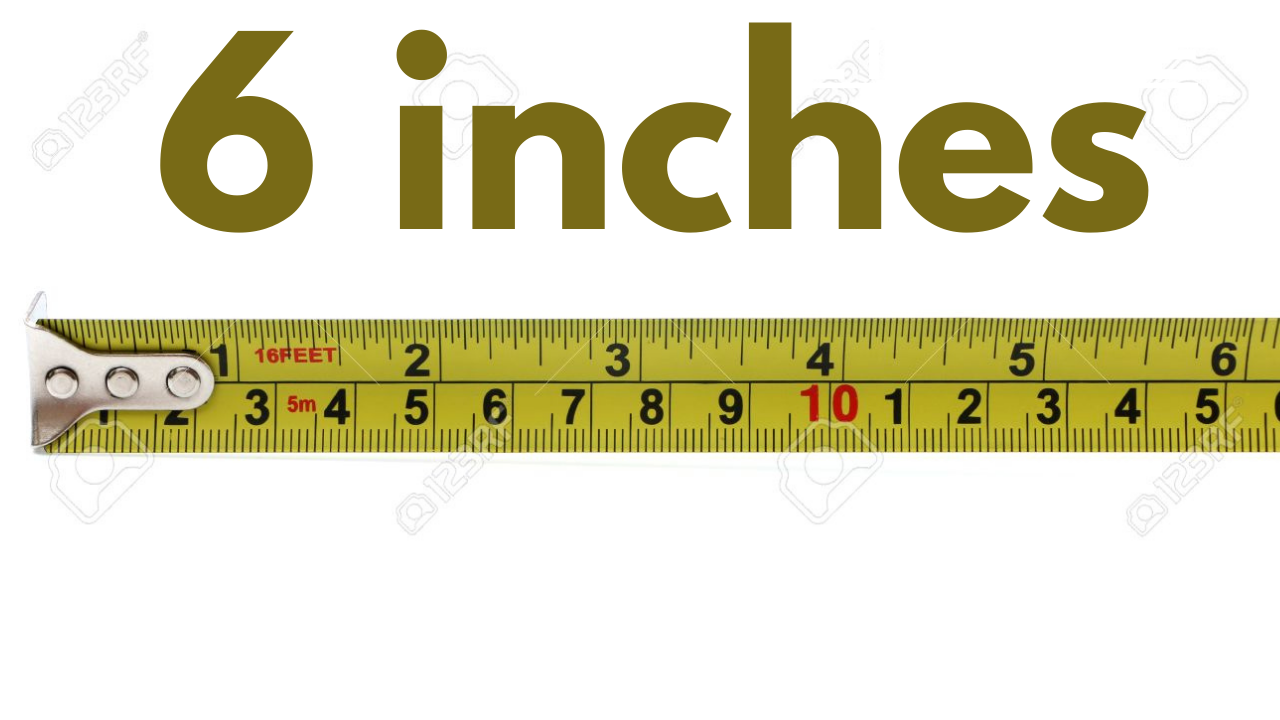6 Inches The Small Size That Makes a Big Impact
In the world of measurements, the number “6 inches” might appear trivial at first glance, yet it carries profound relevance across various aspects of daily life. Whether in fashion, construction, technology, or symbolic representations, this moderate dimension plays a pivotal role. The simplicity of the term “6 inches” belies its versatility and the variety of applications it encapsulates. Understanding this measurement goes far beyond recognizing it as half a foot; it’s about appreciating its functional, aesthetic, and even cultural value.
From smartphone screens to kitchen utensils, garden tools to high-heeled shoes, 6 inches is a dimension we encounter frequently. Its ubiquity makes it a default reference point in many industries and casual conversations alike. But what exactly makes 6 inches such a popular standard? Why does this particular size recur so often across so many domains? In this article, we take a deep dive into the world of 6 inches, exploring its scientific foundations, practical applications, symbolic meanings, and cultural connotations. By the end, you’ll see why this modest measurement punches far above its weight in influence.
The Science and Standardization Behind 6 Inches

The inch, as a unit of measurement, belongs to the Imperial system, predominantly used in countries like the United States. One inch is defined as exactly 2.54 centimeters. Therefore, 6 inches equals 15.24 centimeters or 0.5 feet. The precision and standardization of this unit are crucial in sectors where even the slightest variation can lead to errors—engineering, construction, and manufacturing, to name a few.
The standardization of 6 inches allows industries to design, manufacture, and communicate effectively. For instance, a company producing wooden planks, rulers, or electronic devices ensures compatibility and uniformity through adherence to exact measurements. Even in international trade, understanding and converting measurements accurately between metric and imperial systems ensures smooth operations.
Historically, the inch was derived from various anthropomorphic methods—like the width of a thumb—until it was standardized. In 1959, the international yard and pound agreement among English-speaking nations officially defined the inch as 2.54 cm. This agreement cemented its place in scientific calculations, architectural plans, and educational materials. Thus, 6 inches is not just an arbitrary number but a testament to the evolution of measurement systems aiming for consistency and precision.
6 Inches in Everyday Life
Think about how often we encounter items around 6 inches long. Your smartphone, for example, likely has a screen diagonal close to 6 inches. Pencils, sub sandwiches, small wrenches, and even some remote controls share this common size. This measurement offers an optimal balance—large enough for utility and visibility but small enough for portability and storage.
In home improvement and DIY projects, 6 inches is a frequent reference. Need to hang a picture frame, measure fabric, or align furniture? A 6-inch ruler or tool is often the go-to. In tailoring, 6 inches can determine a hemline adjustment, a collar width, or a cuff length, making it essential in fashion design. Similarly, in gardening, a 6-inch trowel is standard, offering the perfect size for digging or planting small flora.
Cooking also leans on this measurement. A 6-inch chef’s knife is preferred for beginners due to its manageable size and cutting precision. Bakeware often includes 6-inch cake pans, perfect for small batches or layered desserts. From the bedroom to the backyard, kitchen to the classroom, 6 inches proves to be a size that seamlessly integrates into everyday activities.
Cultural and Symbolic Meanings of 6 Inches
Beyond its physical dimension, “6 inches” has found a place in culture, art, and media. One popular reference is Beyoncé’s song “6 Inch,” which metaphorically combines femininity, strength, and ambition through the symbolism of 6-inch heels. High heels of this height often signify confidence, elegance, and power—a physical elevation that translates to a psychological one.
Culturally, the size carries different meanings depending on context. In Western cultures, size often relates to perceptions of adequacy, status, or desirability—be it in fashion, body image, or gadgets. A 6-inch screen might symbolize modernity, compact luxury, or accessibility. Meanwhile, in literature and metaphoric language, 6 inches can denote minimalism or moderation, reminding us that big impact doesn’t always require large scale.
This measurement also enters into everyday vernacular, sometimes playfully, sometimes seriously. It’s used to describe snowfall, rainfall, or even hair growth. The symbolic flexibility of “6 inches” allows it to transcend literal definitions and take on figurative meanings in storytelling, marketing, and communication, often serving as a metaphor for the “just right” balance.
Practical Applications of the 6-Inch Dimension
Technology
In the tech world, the 6-inch smartphone has become a standard. It offers a perfect compromise between screen real estate and hand comfort. Users enjoy enough space for videos, apps, and multitasking, while still being able to operate the device single-handedly. Tablet designs also hover around this dimension for ultra-portable models.
Fashion & Footwear
Heels and boots with 6-inch height are often labeled as statement pieces. These are typically worn for fashion-forward events, photoshoots, or high-impact performances. In fashion accessories, a 6-inch clutch or handbag represents elegance and minimalist design.
Tools & Equipment
Tools like 6-inch adjustable wrenches or drill bits are essential in both professional and amateur toolkits. They’re versatile enough for tight spaces yet powerful for heavy-duty tasks. In plumbing and carpentry, 6-inch pipes or wood planks are commonly used, making the measurement a default size in construction materials.
Home & Décor
In interior design, 6-inch tiles offer symmetry and a classic look, particularly in bathrooms or backsplashes. Bookshelves and drawers are often spaced in 6-inch increments, offering practical storage solutions. Even plant pots and lampshades frequently fall into this size range.
Misconceptions and Misuse of the Term “6 Inches”
Despite its standardized value, “6 inches” is often misrepresented or misunderstood. One of the most common misconceptions is in casual estimations—people tend to over- or underestimate sizes visually, which leads to comical or critical errors. This is particularly evident in fashion, online shopping, and even anatomy discussions, where expectations versus reality can vary wildly.
The misuse also stems from exaggeration. Marketing materials might round up or emphasize “6 inches” for added appeal. However, without precise tools, it’s easy for this to become misleading. That’s why in industries like construction or health care, reliance on accurate measuring instruments is non-negotiable.
Context matters deeply when referencing 6 inches. A 6-inch snowfall might shut down a city, while a 6-inch dessert might seem dainty. Understanding that the impact of this measurement changes depending on setting is essential for clear communication and informed decision-making.
Why Size Matters (and Why It Sometimes Doesn’t)
In fields like engineering or architecture, a deviation of even a fraction of an inch can lead to costly mistakes. Therefore, the exactness of a 6-inch measurement becomes critical. Whether cutting materials or calibrating machinery, the need for precision underscores the importance of size.
Conversely, in more flexible domains like design or fashion, 6 inches can serve as an approximation. A 6-inch floral arrangement doesn’t need millimetric accuracy—it’s about the visual effect. Likewise, in creative storytelling or everyday descriptions, 6 inches acts more symbolically than scientifically.
Moreover, the psychological perception of size often distorts how we interpret measurements. Studies show that humans are notoriously poor at visual estimations. That’s why it’s crucial to not just know what 6 inches is, but also what it means within the context.
Ultimately, size does matter—but so does perspective. Sometimes, the way we perceive 6 inches has more to do with expectations, culture, or need, rather than its physical manifestation.
Conclusion
Six inches may seem like a small number, but it holds enormous value in multiple spheres of life. From technological gadgets and fashion statements to home décor and symbolic language, this dimension proves its significance time and time again. It represents a sweet spot between too much and too little—a perfect middle ground that resonates with functionality, aesthetics, and meaning.
Understanding 6 inches in its many forms offers more than just knowledge—it provides perspective. By appreciating this measurement, we gain insight into how small things can create big impressions, how standardization shapes our world, and how even the simplest figures carry weight beyond numbers.
FAQs
How long is 6 inches in centimeters?
A: 6 inches is exactly 15.24 centimeters.
What are some common items that are about 6 inches long?
A: Examples include smartphones, sub sandwiches, kitchen knives, and picture frames.
Why is 6 inches a common measurement in fashion and tools?
A: It strikes a balance between functionality and compactness, making it ideal for daily use.
Is 6 inches considered big or small?
A: It depends on context—6 inches can be either large or small depending on what it’s measuring.
What is the origin of the inch as a unit?
A: It originated from anthropomorphic measurements like the width of a thumb and was later standardized internationally as 2.54 cm per inch.
You May Also Read: https://otswroldtime.com/monet-poole/














Post Comment